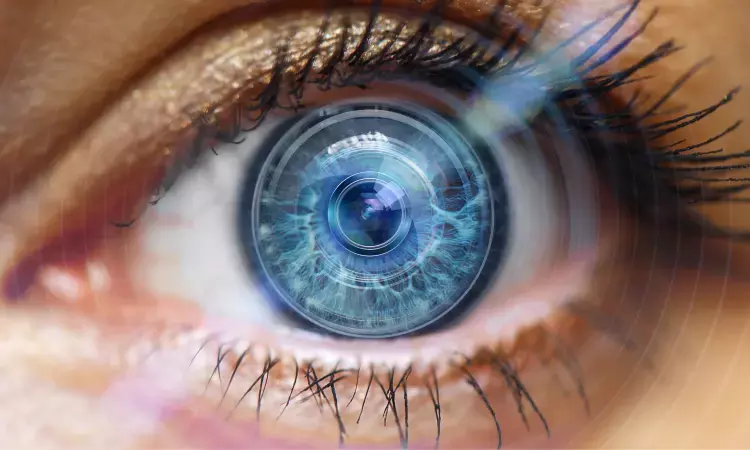- Home
- Medical news & Guidelines
- Anesthesiology
- Cardiology and CTVS
- Critical Care
- Dentistry
- Dermatology
- Diabetes and Endocrinology
- ENT
- Gastroenterology
- Medicine
- Nephrology
- Neurology
- Obstretics-Gynaecology
- Oncology
- Ophthalmology
- Orthopaedics
- Pediatrics-Neonatology
- Psychiatry
- Pulmonology
- Radiology
- Surgery
- Urology
- Laboratory Medicine
- Diet
- Nursing
- Paramedical
- Physiotherapy
- Health news
- Fact Check
- Bone Health Fact Check
- Brain Health Fact Check
- Cancer Related Fact Check
- Child Care Fact Check
- Dental and oral health fact check
- Diabetes and metabolic health fact check
- Diet and Nutrition Fact Check
- Eye and ENT Care Fact Check
- Fitness fact check
- Gut health fact check
- Heart health fact check
- Kidney health fact check
- Medical education fact check
- Men's health fact check
- Respiratory fact check
- Skin and hair care fact check
- Vaccine and Immunization fact check
- Women's health fact check
- AYUSH
- State News
- Andaman and Nicobar Islands
- Andhra Pradesh
- Arunachal Pradesh
- Assam
- Bihar
- Chandigarh
- Chattisgarh
- Dadra and Nagar Haveli
- Daman and Diu
- Delhi
- Goa
- Gujarat
- Haryana
- Himachal Pradesh
- Jammu & Kashmir
- Jharkhand
- Karnataka
- Kerala
- Ladakh
- Lakshadweep
- Madhya Pradesh
- Maharashtra
- Manipur
- Meghalaya
- Mizoram
- Nagaland
- Odisha
- Puducherry
- Punjab
- Rajasthan
- Sikkim
- Tamil Nadu
- Telangana
- Tripura
- Uttar Pradesh
- Uttrakhand
- West Bengal
- Medical Education
- Industry
Bizarre visual symptoms an early warning for Alzheimer's Disease finds study

Alzheimer's characterized by symptoms of dementia still has no cure and several studies are evaluating different factors for its early indication for a better lifestyle in these partients.
A study conducted by an international team of researchers now showed the association of a baffling constellation of visuospatial symptoms like judging distances, distinguishing between moving and stationary objects as the first signs of Alzheimer’s disease.
According to researchers, led by University of California San Francisco (UCSF), who led the first large-scale study of about 1,000 people with posterior cortical atrophy (PCA), the symptoms occur in up to 10 per cent of cases of Alzheimer’s disease.
Posterior cortical atrophy (PCA) overwhelmingly predicts Alzheimer’s, the researchers said in the paper published in the Lancet Neurology with participants from 16 countries.
Some 94 per cent of the PCA patients had Alzheimer’s pathology and the remaining 6 per cent had conditions like Lewy body disease and frontotemporal lobar degeneration.
In contrast, other studies show that 70 per cent of patients with memory loss have Alzheimer’s pathology.
Unlike memory issues, patients with PCA struggle with judging distances, distinguishing between moving and stationary objects and completing tasks like writing and retrieving a dropped item despite a normal eye exam, said Marianne Chapleau, of the UCSF Department of Neurology, the Memory and Aging Center and the Weill Institute for Neurosciences.
Most patients with PCA have normal cognition early on, but by the time of their first diagnostic visit, an average 3.8 years after symptom onset, mild or moderate dementia was apparent with deficits identified in memory, executive function, behaviour, and speech and language, according to the researchers’ findings.
At the time of diagnosis, 61 per cent demonstrated “constructional dyspraxia,” an inability to copy or construct basic diagrams or figures; 49 per cent had a “space perception deficit,” difficulties identifying the location of something they saw; and 48 per cent had “simultanagnosia,” an inability to visually perceive more than one object at a time.
Additionally, 47 per cent faced new challenges with basic Maths calculations and 43 per cent with reading. “We need more awareness of PCA so that it can be flagged by clinicians,” said Chapleau.
“Most patients see their optometrist when they start experiencing visual symptoms and may be referred to an ophthalmologist who may also fail to recognise PCA,” she said.
“We need better tools in clinical settings to identify these patients early on and get them treatment,” she said.
The average age of symptom onset of PCA is 59, several years younger than the typical memory symptoms of Alzheimer’s. This is another reason why patients with PCA are less likely to be diagnosed, Chapleau added.
Early identification of PCA may have important implications for Alzheimer’s treatment, the researchers said.
Reference: Could bizarre visual symptoms be a telltale sign of Alzheimer's?; UNIVERSITY OF CALIFORNIA - SAN FRANCISCO; The Lancet Neurology
MSc. Neuroscience
Niveditha Subramani a MSc. Neuroscience (Faculty of Medicine) graduate from University of Madras, Chennai. Ambitious in Neuro research having worked in motor diseases and neuron apoptosis is interested in more of new upcoming research and their advancement in field of medicine. She has an engrossed skill towards writing and her roles at Medical dialogue include Sr. Content writer. Her news covers new discoveries and updates in field of medicine. She can be reached at editorial@medicaldialogues.in
Dr Kamal Kant Kohli-MBBS, DTCD- a chest specialist with more than 30 years of practice and a flair for writing clinical articles, Dr Kamal Kant Kohli joined Medical Dialogues as a Chief Editor of Medical News. Besides writing articles, as an editor, he proofreads and verifies all the medical content published on Medical Dialogues including those coming from journals, studies,medical conferences,guidelines etc. Email: drkohli@medicaldialogues.in. Contact no. 011-43720751


